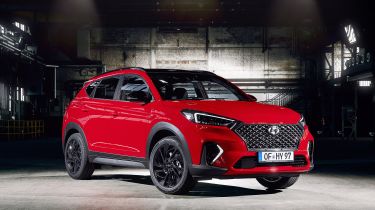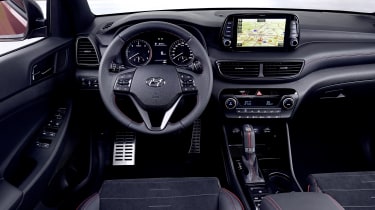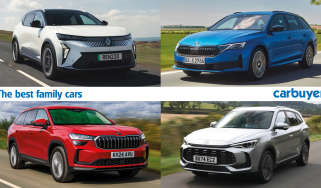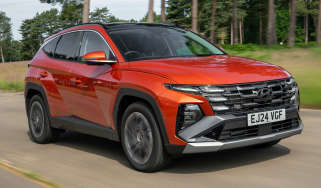Hyundai Tucson N Line pricing announced
Sporty N Line models start at £25,995
The Hyundai Tucson N Line will start from £25,995, the company has confirmed. The new N Line trim offers customers sporty looks and a slightly enhanced driving experience without compromising either comfort or efficiency, in a similar way to Audi S-Line, Ford ST-Line and SEAT FR trims. The Hyundai Tucson N Line will go on sale on Friday 31st May as a rival to the sportiest models of the Ford Kuga, Nissan Qashqai and Peugeot 3008.
The N Line range consists of a 175bhp 1.6-litre petrol engine with a manual gearbox that costs £25,995 and a mild-hybrid 134bhp 1.6-litre diesel priced at £27,760. Specifying a dual-clutch automatic transmission adds £1,290 to the price of both variants.
The N Line trim brings slightly more aggressive styling to the Tucson. Just like the Hyundai i30 N Line, styling changes include a new front bumper with larger air intakes, a dark chrome grille and darkened headlight units. It rides on black 19-inch alloy wheels, and the black accents continue on the roof, spoiler and door mirrors. The SUV looks are still present thanks to plastic body cladding and a scuff plate underneath the rear bumper, which is painted in dark grey. A pair of real exhaust pipes complete the styling changes.
Most reliable cars you can buy in 2019
To highlight its position as the most sporty model (at least until a hot Tucson N appears), Hyundai has added red contrast stitching to the interior. Including the steering wheel, seats and dashboard, and around the gear lever. The front seats are trimmed in a mix of artificial leather and a suede-like fabric, with aluminium pedals adding a sporty touch. There’s also gloss black interior finishing, while standard features include a premium audio system.
The N Line sits between the SE Nav and top-spec Premium trim levels and includes two-zone climate control, tinted windows, a rear-view camera and parking sensors, smartphone screen mirroring, sat nav and an eight-inch touchscreen with Android Auto and Apple CarPlay. The seats are trimmed in a mix of leather and suede, and are heated in the front. Safety kit includes auto emergency braking, lane-keeping assistance, speed limit recognition and trailer stabilisation. Seven colours are available but you’ll have to pay £665 extra if you’d like any of the five metallic or pearl options.
While it doesn’t get any more power, the Tucson N Line does feature chassis improvements to improve handling, with slightly firmer dampers and weightier steering. You’ll need to choose the petrol engine to get these enhancements, though, as N Line models with a diesel engine will be set up exactly the same as the standard versions.
At launch, the N Line Tucson is available with a choice of two 1.6 litre engines. The first is a petrol engine producing 175bhp that can accelerate from 0-62mph in under 9 seconds when specced with the seven-speed automatic gearbox. Also available is a 1.6-litre diesel engine with mild hybrid technology. It’s assisted by a 48V electrical system that allows the diesel engine to engage the stop/start system by shutting down the engine during braking helping to increase fuel and emissions efficiency. This is assisted by a new brake regeneration system that can feed the energy recovered into the driven wheels.
These additions helps reduce carbon emissions by up to 11% according to Hyundai when compared to the standard 1.6-litre diesel engine. As a result, you can expect to achieve up to 50mpg from the diesel in mixed driving, or 36mpg from the petrol. Both will be offered with both a six-speed manual gearbox and seven-speed dual-clutch automatic gearbox.
For more details read our review of the Hyundai Tucson, or see how it compares to the competition on our list of the best medium-sized SUVs you can buy.
Recommended
Most Popular

Suzuki’s new 10-year warranty is free – here’s how to get it
Tips & advice

Car dashboard warning lights: what does each symbol mean?

Electric car charging stations: public networks, charger types, apps and maps












